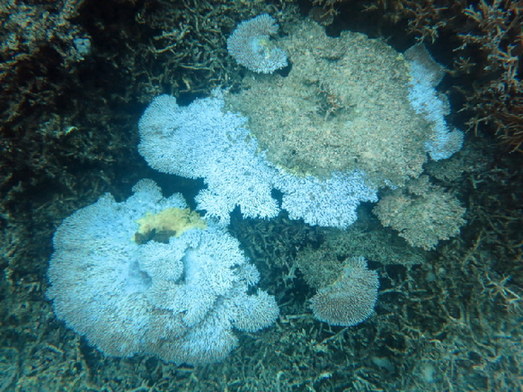Coral bleaching threat increasing in W. Atlantic, Pacific oceans
 0 Comment(s)
0 Comment(s) Print
Print E-mail NOAA, July 8, 2015
E-mail NOAA, July 8, 2015
As unusually warm ocean temperatures cover the north Pacific, equatorial Pacific, and western Atlantic oceans, NOAA scientists expect greater bleaching of corals on Northern Hemisphere reefs through October, potentially leading to the death of corals over a wide area and affecting the long-term supply of fish and shellfish.
 |
|
Bleached and dead Acorpora coral in the National Marine Sanctuary of American Samoa. [Photo / NOAA] |
While corals can recover from mild bleaching, severe or long-term bleaching kills corals. Even if corals recover, they are more susceptible to disease. Once corals die, it usually takes decades for the reef to recover -- but recovery is only possible if the reefs are undisturbed. After corals die, reefs degrade and the structures corals build are eroded away, providing less shoreline protection and less habitat for fish and shellfish.
"The bleaching that started in June 2014 has been really bad for corals in the western Pacific," said Mark Eakin, NOAA Coral Reef Watch coordinator. "We are worried that bleaching will spread to the western Atlantic and again into Hawaii."
Earlier this year, NOAA's Coral Reef Watch four-month Coral Bleaching Outlook accurately predicted coral bleaching in the South Pacific, including the Solomon Islands, Papua New Guinea, Nauru, Fiji, and American Samoa. It also recently predicted the coral bleaching in the Indian Ocean, including the British Indian Ocean Territory and the Maldives.
Coral bleaching occurs when corals are stressed by changes in environmental conditions such as temperature, light or nutrients. The coral expels the symbiotic algae living in its tissue, causing the tissue to turn white or pale. Without the algae, the coral loses its major source of food and is more susceptible to disease. Scientists note, however, that only high temperatures can cause bleaching over wide areas like those seen since 2014.
In fall 2014, Hawaii saw widespread coral bleaching for the first time since 1996. If corals in Hawaii bleach again this year, it would be the first time it happened in consecutive years in the archipelago.
Warmer ocean temperatures in 2014 also dealt a blow to coral nurseries in the Florida Keys, where scientists are growing threatened coral species to transplant onto local reefs. Coral reefs in Florida and the Caribbean have weathered repeated and worsening coral bleaching events for the past thirty years. The NOAA Coral Reef Watch monitoring team says that more bleaching so soon could spell disaster for corals that have yet to recover from last year's stress.
"Many healthy, resilient coral reefs can withstand bleaching as long as they have time to recover," Eakin said. "However, when you have repeated bleaching on a reef within a short period of time, it's very hard for the corals to recover and survive. This is even worse where corals are suffering from other environmental threats, like pollution or overfishing," he said.






Go to Forum >>0 Comment(s)